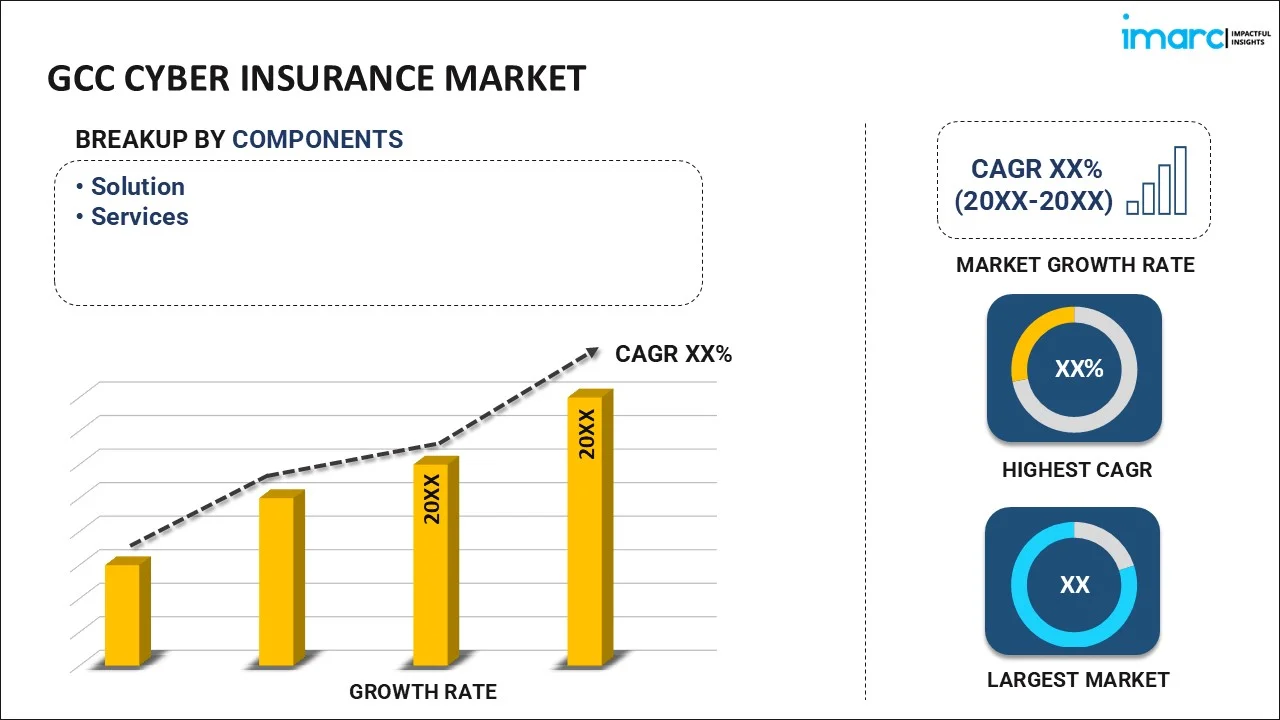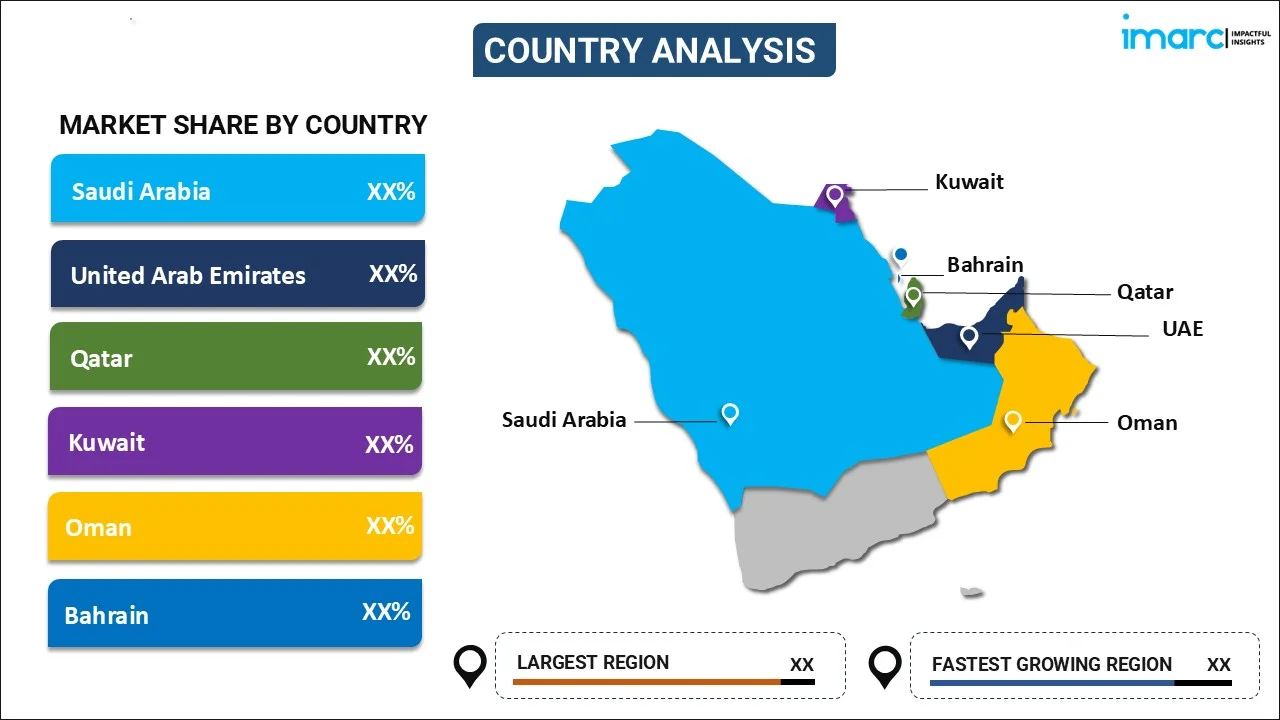
GCC Cyber Insurance Market Report by Component (Solution, Services), Insurance Type (Packaged, Stand-alone), Organization Size (Small and Medium-sized Enterprises, Large Enterprises), End Use Industry (BFSI, Healthcare, IT and Telecom, Retail, and Others), and Country 2025-2033
Market Overview:
The GCC cyber insurance market size is projected to exhibit a growth rate (CAGR) of 20.78% during 2025-2033. The escalating number of cyber-attacks, implementation of strict regulations and policies, growing digitalization across industries, continuous expansion of e-commerce and online banking platforms, escalating utilization of cloud-based services, and the shifting trends towards bring your own device (BYOD) represent some of the key factors driving the market.
|
Report Attribute
|
Key Statistics
|
|---|---|
|
Base Year
|
2024
|
|
Forecast Years
|
2025-2033
|
|
Historical Years
|
2019-2024
|
| Market Growth Rate 2025-2033 | 20.78% |
Cyber insurance refers to a specialized form of insurance designed to protect businesses and individuals from Internet-based frauds and risks related to information technology (IT) infrastructure. It is designed to mitigate losses from various cyber incidents, including network damage, data breaches, and cyber extortion. Cyber insurance provides first-party and third-party coverage, with features, such as legal fees coverage, notification costs, identity protection, public relations support, and business interruption loss recovery. It is issued by insurance companies, specialized cyber insurance firms, reinsurers, tech companies, financial institutions, risk management firms, and industry associations. Cyber insurance finds extensive applications in financial services, healthcare, retail, manufacturing, energy, transportation, education, government, media, and hospitality sectors. It offers several benefits, including risk management support, compensation for data loss, network security liability, protection against intellectual property rights infringement, and cost-effective compliance with regulations. In addition, it aids in providing a structured approach to cybersecurity, supporting crisis management, fostering consumer trust, maintaining business reputation, and enhancing operational resilience.
GCC Cyber Insurance Market Trends:
The escalating number of cyber-attacks in the region, coupled with the increasing awareness about the necessity of cyber insurance, is propelling the market growth. In addition, the implementation of strict regulations and policies by the regional government pertaining to data protection and privacy has prompted several organizations to adopt insurance policies. Furthermore, the growing digitalization across industries, which is creating potential risks of fraud and illegal activities, is positively influencing the market growth. Additionally, the continuous expansion of e-commerce and online banking platforms that are at high risk of data breaches and cyberattacks is contributing to the market growth. Apart from this, the growing insurance demand owing to the escalating utilization of cloud-based services that are highly vulnerable to breaches is strengthening the market growth. Moreover, the shifting trend towards bring your own device (BYOD) policies in corporations, which necessitates additional protection to protect employee data and intellectual properties, is catalyzing the market growth. Along with this, the widespread insurance utilization due to the escalating adoption of Internet of Things (IoT) devices across industries, leading to heightened vulnerabilities, is supporting the market growth. In addition, the growing consumer awareness about personal data security and privacy is facilitating the insurance demand. Furthermore, the increasing strategic alliances and collaborations between insurance companies and technology firms to facilitate easy deployment and enhance efficiency are fueling the market growth. Moreover, the ongoing investments in cybersecurity research, coupled with the development of customized insurance products tailored to specific industry needs, are favoring the market growth.
GCC Cyber Insurance Market Segmentation:
IMARC Group provides an analysis of the key trends in each segment of the GCC cyber insurance market report, along with forecasts at the regional and country levels for 2025-2033. Our report has categorized the market based on component, insurance type, organization size, and end use industry.
Component Insights:

- Solution
- Services
The report has provided a detailed breakup and analysis of the market based on the component. This includes solution and service.
Insurance Type Insights:
- Packaged
- Stand-alone
The report has provided a detailed breakup and analysis of the market based on the insurance type. This includes packaged and stand-alone.
Organization Size Insights:
- Small and Medium-sized enterprises
- Large Enterprises
The report has provided a detailed breakup and analysis of the market based on the organization size. This includes small and medium-sized enterprises and large enterprises.
End Use Industry Insights:
- BFSI
- Healthcare
- IT and Telecom
- Retail
- Others
The report has provided a detailed breakup and analysis of the market based on the end use industry. This includes BFSI, healthcare, IT and Telecom, retail, and others.
Country Insights:

- Saudi Arabia
- UAE
- Qatar
- Bahrain
- Kuwait
- Oman
The report has also provided a comprehensive analysis of all the major regional markets, which include Saudi Arabia, UAE, Qatar, Bahrain, Kuwait, and Oman.
Competitive Landscape:
The report has also provided a comprehensive analysis of the competitive landscape in the market. Competitive analysis such as market structure, key player positioning, top winning strategies, competitive dashboard, and company evaluation quadrant has been covered in the report. Also, detailed profiles of all major companies have been provided.
GCC Cyber Insurance Market Report Coverage:
| Report Features | Details |
|---|---|
| Base Year of the Analysis | 2024 |
| Historical Period | 2019-2024 |
| Forecast Period | 2025-2033 |
| Units | Million USD |
| Scope of the Report | Exploration of Historical and Forecast Trends, Industry Catalysts and Challenges, Segment-Wise Historical and Predictive Market Assessment:
|
| Components Covered | Solution, Services |
| Insurance Types Covered | Packaged, Stand-alone |
| Organization Sizes Covered | Small and Medium-sized Enterprises, Large Enterprises |
| End Use Industries Covered | BFSI, Healthcare, IT and Telecom, Retail, Others |
| Countries Covered | Saudi Arabia, UAE, Qatar, Bahrain, Kuwait, Oman |
| Customization Scope | 10% Free Customization |
| Post-Sale Analyst Support | 10-12 Weeks |
| Delivery Format | PDF and Excel through Email (We can also provide the editable version of the report in PPT/Word format on special request) |
Key Questions Answered in This Report:
- How has the GCC cyber insurance market performed so far and how will it perform in the coming years?
- What has been the impact of COVID-19 on the GCC cyber insurance market?
- What is the breakup of the GCC cyber insurance market on the basis of component?
- What is the breakup of the GCC cyber insurance market on the basis of insurance type?
- What is the breakup of the GCC cyber insurance market on the basis of organization size?
- What is the breakup of the GCC cyber insurance market on the basis of end use industry?
- What are the various stages in the value chain of the GCC cyber insurance market?
- What are the key driving factors and challenges in the GCC cyber insurance market?
- What is the structure of the GCC cyber insurance market and who are the key players?
- What is the degree of competition in the GCC cyber insurance market?
Key Benefits for Stakeholders:
- IMARC’s report offers a comprehensive quantitative analysis of various market segments, historical and current market trends, market forecasts, and dynamics of the GCC cyber insurance market from 2019-2033.
- The research study provides the latest information on the market drivers, challenges, and opportunities in the GCC cyber insurance market.
- Porter's five forces analysis assist stakeholders in assessing the impact of new entrants, competitive rivalry, supplier power, buyer power, and the threat of substitution. It helps stakeholders to analyze the level of competition within the GCC cyber insurance industry and its attractiveness.
- Competitive landscape allows stakeholders to understand their competitive environment and provides an insight into the current positions of key players in the market.
Need more help?
- Speak to our experienced analysts for insights on the current market scenarios.
- Include additional segments and countries to customize the report as per your requirement.
- Gain an unparalleled competitive advantage in your domain by understanding how to utilize the report and positively impacting your operations and revenue.
- For further assistance, please connect with our analysts.
 Inquire Before Buying
Inquire Before Buying
 Speak to an Analyst
Speak to an Analyst
 Request Brochure
Request Brochure
 Request Customization
Request Customization




.webp)




.webp)












